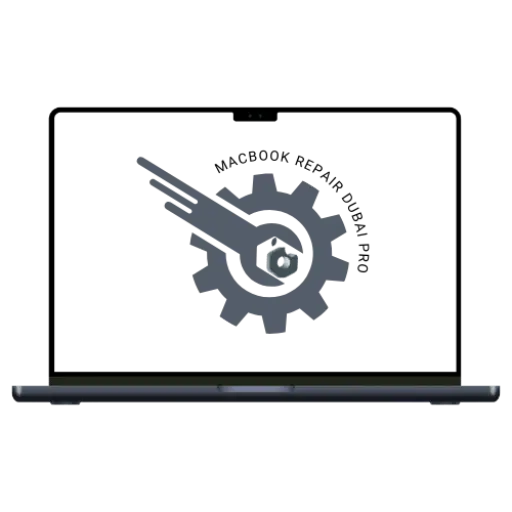How Do I Reset Passwords on My MacBook?
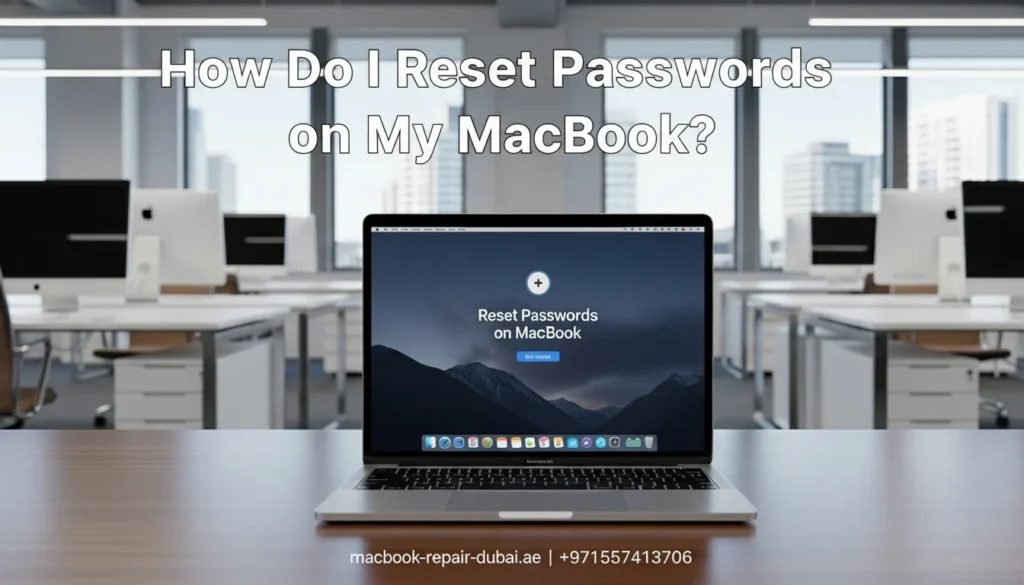
How Do I Reset Passwords on My MacBook? Forgetting your MacBook password can be stressful, but the good news is, Apple gives you multiple ways to reset it. Whether you have changed your password recently or just have not used your device in a while, resetting your MacBook password is a quick process if you follow the right steps. In this guide, we will walk you through several easy methods to reset your MacBook login password. And if nothing works, do not panic MacBook Repair Dubai is here to help with professional support across the UAE. When and Why to Reset Your MacBook Password Here are some common situations where you might need to reset your Mac password: You may have simply forgotten your password. You have just purchased a secondhand Mac, and it is still tied to the old user. There has been a system error or software bug. You changed iCloud or Apple ID credentials and got locked out. Your Mac is showing a 403 Forbidden error or won’t connect to Apple servers. Locked Out of Your MacBook? 4 Easy Ways to Reset Your Password Method 1: Use Your Apple ID to Reset Your Password If you linked your MacBook to your Apple ID, resetting your password is simple. Steps: At the login screen, enter the wrong password three times. You will then see the option to reset it using your Apple ID. Click the arrow or reset button. Enter your Apple ID and password. Set a new Mac password and sign in. Note: This method works only if you are connected to Wi-Fi and FileVault is turned off. If it is turned on, skip to the next method. Method 2: Reset Password Using Recovery Mode If resetting with your Apple ID does not work, try using macOS Recovery Mode instead. Steps: Turn off your MacBook. Hold down Command (⌘) + R, then press the power button to turn it back on. Let go of the keys when you see the Apple logo or spinning globe. Once in macOS Utilities, click Terminal in the top menu. Type this command: reset password and press Enter. The Reset Password utility will appear. Choose your user account, set a new password with a hint, then restart and log in. If MacBook Data Recovery Mode is not working, visit us for help. Method 3: Reset Your Password Using an Admin Account If someone else also uses your MacBook, and they have admin access, they can reset your password for you. Steps: Sign in to your Mac using the admin account. Navigate to System Settings and select Users & Groups. Click the lock and enter the admin password. Select the account to reset. Hit Reset Password, type in your new one twice, and you are good to go. This method is useful in shared computers or family devices. Method 4: Erase and Reinstall macOS (Last Resort) If all else fails, you may need to erase the disk and reinstall macOS. Warning: This will delete all your data. Always try to back up with Time Machine or iCloud if possible before doing this. Steps: Enter macOS Recovery Mode (Command + R during startup). Open Disk Utility, pick your drive, and hit Erase to wipe it clean. After erasing, go back and choose Reinstall macOS. Follow the on-screen instructions. Once your Mac is restored, you can set up a new password and account. Prevent Future Lockouts After resetting your password, take some simple steps to avoid future problems: Turn on the iCloud Keychain to manage and store passwords securely. Enable FileVault to encrypt your drive (but remember your password). Set a password hint during setup to make recovery easier. Use Touch ID (if available) or Apple Watch unlock for quick access. Need Help? Contact Us If you are stuck, or something goes wrong during the reset process, do not worry. At MRD, we handle all types of Mac login and password recovery issues. Whether your device is locked due to a forgotten password, corrupted system, or iCloud-related problems, our expert team is ready to assist you quickly and securely. Why choose us? Same-day support across Dubai and UAE Professional Mac password recovery Data protection guaranteed Affordable rates with no hidden charges Visit MacBook Repair Dubai today or call us to book your service. Final Thoughts Resetting the password on your MacBook is not as scary as it sounds. With a few simple steps whether it is using your Apple ID, recovery mode, or another admin you can regain access to your Mac in no time. Need quick help? Contact Us Now and let our expert technicians handle everything for you — fast, safe, and hassle-free. Final Contact Form First NameLast NameEmailPhone NumberDevice ModelYour MessageSubmit Form Related Posts Mac Guide Why Is My MacBook (M3) Not Charging? May 22, 2025-Abdul Aziz … Read More… How Can I Fix a MacBook Air That Won’t Charge? May 22, 2025-Abdul Aziz … Read More… How to Take a Screenshot on a MacBook May 15, 2025-Abdul Aziz … Read More… How to Change MacBook Name May 15, 2025-Abdul Aziz … Read More… How to Install Windows on MacBook Pro May 15, 2025-Abdul Aziz … Read More… How to Reset a MacBook May 15, 2025-Abdul Aziz … Read More… Load More End of Content.
How can I record audio while screen recording on Mac?
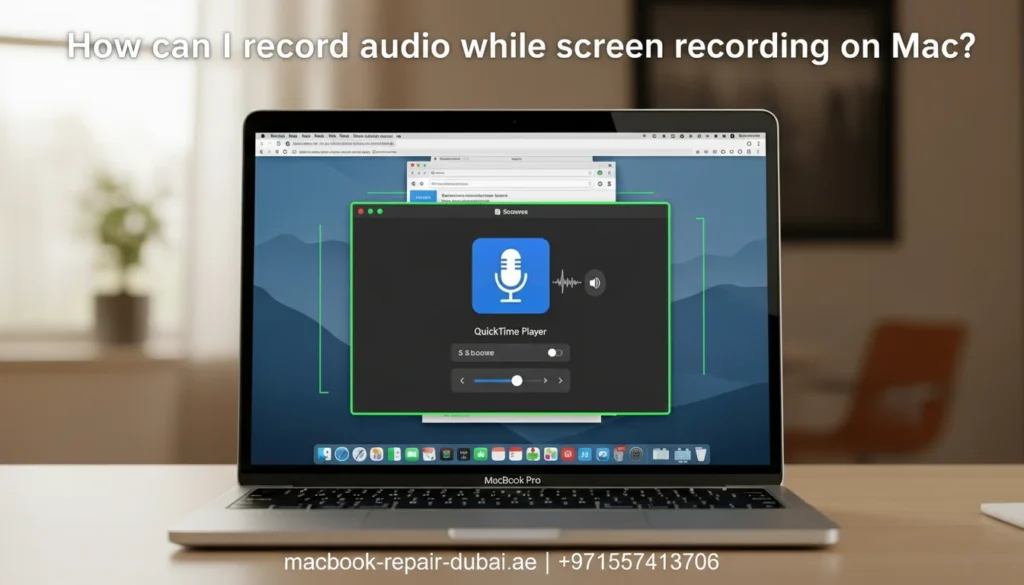
How can I record audio while screen recording on Mac? Screen recording on a Mac is a helpful element, whether you are making tutorials, capturing gameplay, or saving online meetings. But sometimes, users have difficulties recording audio along with the screen, either from the system’s sound or an external microphone. Without audio, screen recordings may feel incomplete and less useful. The good news is that it is easy to record audio along with a screen recording on a Mac once you figure it out. Here at MacBook Repair Dubai, we help users get the most out of their MacBook daily. Let’s go over the steps for easy audio and screen recording. 1. Utilize the Integrated Screenshot Toolbar Quickly record the screen with mic audio: Press Command + Shift + 5 to access the screenshot toolbar. Click on the Record Entire Screen or Record Selected Portion button. Before starting, click Options and choose Built-in Microphone under Microphone. Press Record your screen, and your voice will now be captured. Note: The screenshot toolbar does not capture internal system audio, only microphone data. 2. Record System Audio with Third-Party Apps Record screen with both system and mic audio: Download the free application BackHoe or Sound flower; these plugins will enable you to route system audio for recording. Upon installation, set the extensions to the output device in the system settings under sound. Open QuickTime Player and select New Screen Recording from the file tab. Select the virtual audio device for the microphone. Press record, and the system audio, alongside your screen, will be recorded. 3. Screen and Audio Recording with QuickTime Player QuickTime Player simplifies external audio recording: Open QuickTime Player and select File > New Screen Recording. Click the arrow next to the record button and choose Built-in Microphone. Hit Record, then click the stop button in the menu bar when you are finished. Conclusion Capturing your Mac’s screen with audio is easy when you see the right settings and tools. Whether you are using the built-in screenshot toolbar, QuickTime Player, or a third-party app for system audio, you can easily capture clear video and sound. If you still face technical issues or need expert help with your MacBook’s audio or screen recording features, don’t hesitate to contact us at MacBook Repair Dubai — we’re always here to assist you with fast and professional support. Final Contact Form First NameLast NameEmailPhone NumberDevice ModelYour MessageSubmit Form Related Posts Mac Guide Why Is My MacBook (M3) Not Charging? May 22, 2025-Abdul Aziz … Read More… How Can I Fix a MacBook Air That Won’t Charge? May 22, 2025-Abdul Aziz … Read More… How to Take a Screenshot on a MacBook May 15, 2025-Abdul Aziz … Read More… How to Change MacBook Name May 15, 2025-Abdul Aziz … Read More… How to Install Windows on MacBook Pro May 15, 2025-Abdul Aziz … Read More… How to Reset a MacBook May 15, 2025-Abdul Aziz … Read More… Load More End of Content.
How to fix wireless issues on my MacBook with Linksys Velop Pro 7?
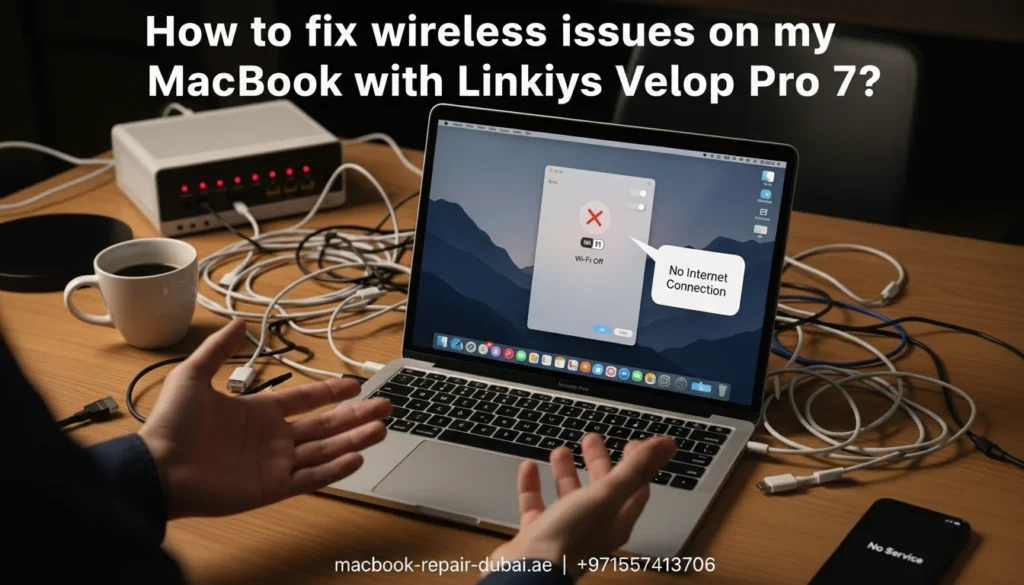
How to fix wireless issues on my MacBook with Linksys Velop Pro 7? A stable and high-speed Wi-Fi connection is important for your MacBook. But sometimes, when using the Linksys Velop Pro 7, your MacBook may face wireless issues like slow speeds, repeated disconnections, or problems connecting to the network. It can disrupt your work, streaming, or browsing experience. Do not worry! These Wi-Fi problems can usually be fixed with simple troubleshooting steps. At MRD, we help users solve connectivity issues every day. Let’s search why your MacBook struggles with the Linksys Velop Pro 7 and how to fix it. Why Your MacBook Has Wireless Issues with Linksys Velop Pro 7 Several factors could cause Wi-Fi problems between your MacBook and Linksys Velop Pro 7: Network interference: Nearby devices or walls may weaken the signal. Router settings: The Linksys Velop Pro 7s structure may not be improved for your MacBook. Outdated software: Old macOS versions or software update issues can cause connectivity problems. IP address Overlaps: Too many devices on the same network can cause address conflicts. Troubleshooting Wireless Issues on MacBook with Linksys Velop Pro 7 Just follow this guide to fix your unstable Wi-Fi connection. 1. Restart your MacBook and Router Shut down your MacBook and disconnect the router, Linksys Velop Pro 7. Reconnect the router, wait for 30 seconds, and then power on your MacBook. It might help reset the connections on your devices. For other MacBook troubleshooting tips, see our MacBook repair services. 2. Forget and Rejoin the Wi-Fi Network Head over the System Settings > Wi-Fi. Tap the details icon next to the network name and select forget this network. To reconnect, select the network and enter the password. 3. Check Network Settings Confirm that Wi-Fi is enabled and ensure your MacBook is joined to the intended Wi-Fi network. 4. Update macOS and Router Firmware For your MacBook: Go to System Settings > General > Software Update and install any available updates. For the Linksys Velop Pro 7: Open the Linksys app and check for firmware updates in the settings. 5. Reset Network Settings on MacBook Open System Settings > Network, choose your Wi-Fi network and click the minus (-) button to remove it. Restart your MacBook and add the network back. 6. Adjust the Wi-Fi Band and Channel Launch the Linksys app, and then click Wi-Fi Settings. The MacBook responds more positively to toggling between 2.4 GHz and 5 GHz bands. Do attempt to change the channel to a different one on the network, as it might help with contention from neighboring networks. 7. Reboot the Linksys Velop Pro 7 You need to hold the reset button at the back of the router for 10-15 seconds or until the light starts blinking. You can move the router around using the Linksys app, then pair your MacBook again. Seek Professional Help In case the problem continues, the cause of issues likely lies within the MacBook hardware or the network adaptor. MRD has expert diagnostics and repair services to ensure that your Wi-Fi functions flawlessly. Conclusion Wireless connection issues between your MacBook and the Linksys Velop Pro 7 can be frustrating but are often simple to fix. Restarting devices, updating software, and adjusting network settings usually restore stable Wi-Fi. For expert assistance, contact MacBook Repair Dubai for professional support and repairs. Stay connected and get your MacBook Wi-Fi working perfectly again today. Final Contact Form First NameLast NameEmailPhone NumberDevice ModelYour MessageSubmit Form Related Posts MacBook Repair Dubai MacBook WiFi Issues How to fix wireless issues on my MacBook with Linksys Velop Pro 7? March 26, 2025-Abdul Aziz … Read More… Back-to-School MacBook Tune-Up Special | MacBook Repair Dubai August 27, 2024-Abdul Aziz … Read More…
How can I inherit Folder Permissions on a MacBook?
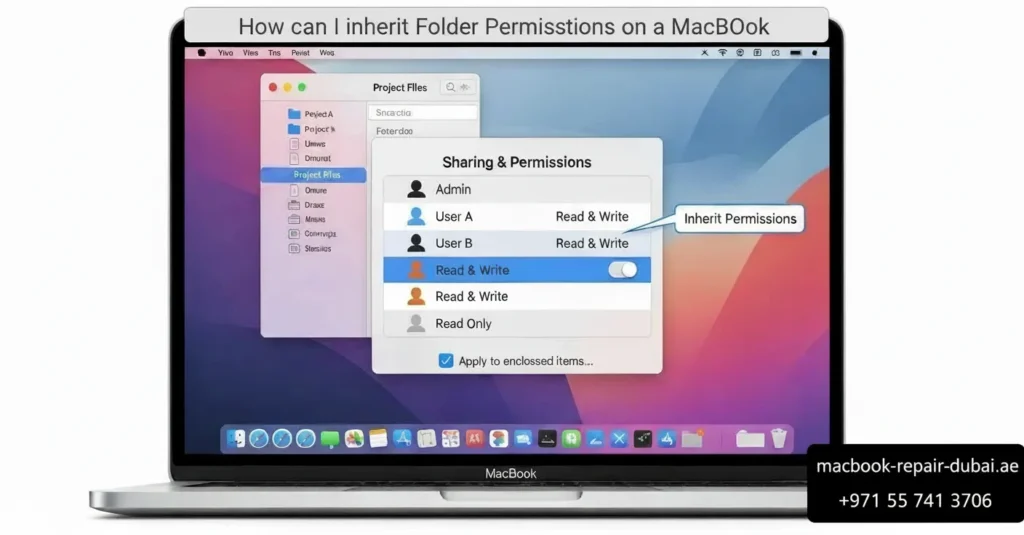
How can I inherit Folder Permissions on a MacBook? Sometimes, you might run into folder permission problems on your MacBook. When you try to open or move files, a message appears stating that you do not have the necessary permissions. It can be confusing and irritating, especially when it happens with your files and folders. You can fix this issue quickly by modifying the permissions in the genetics folder. In this guide, MacBook Repair Dubai will show you simple steps to take ownership and manage folder permissions on your MacBook. If you’re also dealing with macOS update errors or access issues, these steps may help prevent further complications. The Importance of Inheriting Folder Permissions on MacBook? Folder permissions determine who can access, modify, or delete files within that folder. You may need to succeed in permissions if: You transferred files from another Mac and lost access rights. Files were copied from an external drive, and permissions did not transfer. You see, you do not have permissions errors when trying to open or edit files. For users facing persistent system issues or unusual Mac behavior, it’s worth checking how long your MacBook might last and whether permissions issues are part of broader software wear. How to Inherit Folder Permissions on MacBook Let’s fix folder permissions step by step. 1. Check Folder Permissions Right-click the folder with the issue with choose get info. Move down to the sharing and permissions section. Verify that your user account has read and write permissions. If not, this needs to be changed. 2. Change Permissions To access your MacBook, select the lock icon in the bottom right and input your password. Choose your username and adjust the privilege to read and write. If your username is not shown, click the plus button, add your account, and adjust the permissions to read and write. 3. Apply Permissions to All Enclosed Items Once your user account has the right access, click the gear icon (⚙️) below the permissions list. Select Apply to enclosed items to ensure all files and subfolders inherit the same permission. Verify when asked, and wait for the process to complete. 4. Reset Permissions Using Terminal (Optional) If folder permissions still do not work, use the terminal: Open Terminal from Applications > Utilities. Type the following command (replace “FolderPath” with your actual folder location): sudo chown -R $(whoa me) “FolderPath” Hit enter, enter your password when asked, and let the command process. When to Seek Professional Help If folder permissions remain faulty or the issue keeps coming back, there could be deeper system issues. At MRD our expert can resolve complex macOS issues quickly and smoothly. Conclusion Ensuring folder permissions are inherited on your MacBook prevents frustrating access restrictions. These straightforward steps will help you confirm that your files and folders have the right permissions. If you run into any problems, MacBook Repair Dubai is always ready to help with expert support and repair services. Get your MacBook working smoothly again today. Get your MacBook working smoothly again today. For any assistance, feel free to Contact Us. Final Contact Form First NameLast NameEmailPhone NumberDevice ModelYour MessageSubmit Form Related Posts Mac Guide Why Is My MacBook (M3) Not Charging? May 22, 2025-Abdul Aziz … Read More… How Can I Fix a MacBook Air That Won’t Charge? May 22, 2025-Abdul Aziz … Read More… How to Take a Screenshot on a MacBook May 15, 2025-Abdul Aziz … Read More… How to Change MacBook Name May 15, 2025-Abdul Aziz … Read More… How to Install Windows on MacBook Pro May 15, 2025-Abdul Aziz … Read More… How to Reset a MacBook May 15, 2025-Abdul Aziz … Read More… Load More End of Content.
The Macbook does not see the internal SSD
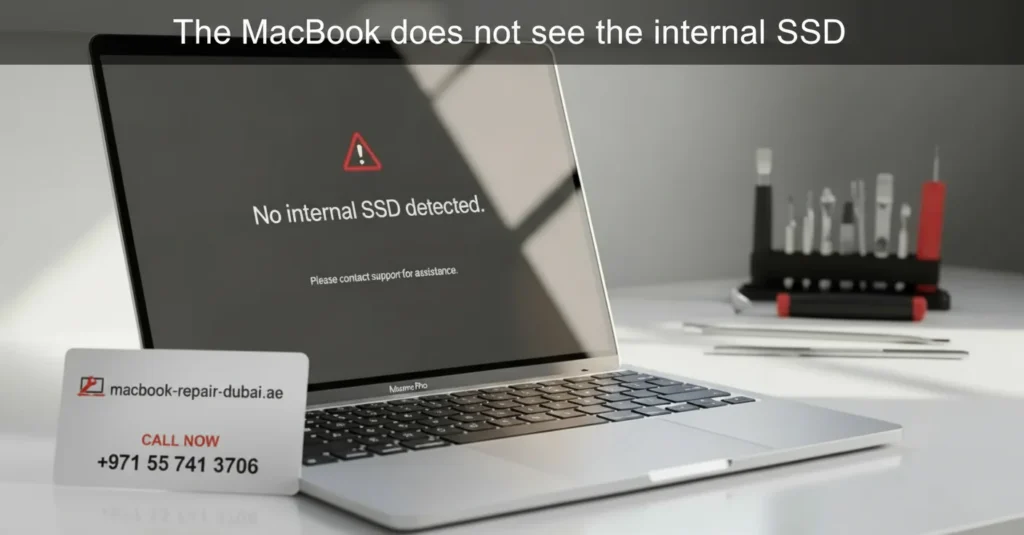
The Macbook does not see the internal SSD It is frustrating when your MacBook can not detect its internal SSD. You may see that the MacBook would not power on, show a folder with a question mark, or do not identify the SSD in the disk function. It may restrict access to essential files and disrupt your device’s normal functionality. But do not worry; this issue is usually easy to fix with a few simple steps. At Macbook Repair Dubai, we are experts in resolving MacBook issues quickly and professionally. Follow these simple steps to help your MacBook detect the SSD again quickly. Why Is Not My MacBook Detecting the Internal SSD? Some factors could prevent your MacBook from seeing the internal SSD: Loose or faulty connection: The SSD may not be properly connected to the MacBook motherboard. Corrupted macOS: A system failure could stop your MacBook from detecting the drive. SSD failure: The internal SSD could be damaged or faulty. Software issues: Expired firmware or system bugs may cause diagnosis problems. How to Fix a MacBook That Doesn’t Detect the Internal SSD Let’s go through these troubleshooting steps one by one. 1. Check Disk Utility To enter macOS Recovery Mode on your MacBook, restart the device and hold down Command + R during the startup process. Open Disk Utility from the macOS Utilities window immediately to take charge of your storage management. Look for your internal SSD in the list of available drivers. If it is there but not installed, click install and check if your files appear. 2. Run First Aid on the SSD In the disk utility, select your internal SSD. Click First Aid and choose Run to fix any drive errors. After the process is complete, restart your MacBook to see if the drive is detected. 3. Reset the SMC (System Management Controller) Shut down your MacBook completely. For MacBooks with non-removable batteries: Press and hold Shift + Control + Option on the left side and the power button for 10 seconds. Release all keys, then press the power button again to turn on your MacBook. For MacBooks with removable batteries: Remove the battery and charger. Hold the power button for 10 seconds, then reconnect and power on the MacBook. 4. Restore NVRAM/PRAM Settings Shut down your MacBook. Please turn it on again and immediately hold down Option + Command + P + R. Hold the keys until you hear the startup sound or see the Apple logo flash twice. Once the MacBook restarts, check if the SSD is detected. 5. Reinstall macOS If your SSD is clear but your MacBook does not power on, macOS might be faulty. Enter macOS Recovery mode and select to reinstall macOS. Follow the on-screen steps to restore your system. It will reinstall macOS without deleting your files (but always back up if possible). 6. Check Hardware Connections (Advanced) If you are pleasant opening your MacBook, carefully check if the SSD is properly connected to the logic board. Ensure there is no dust or damage around the SSD connector. If you are not sure how to do this, visit MRD for professional help. When to Seek Professional Help If none of these solutions do not work the internal SSD or logic board may be faulty. At MRD, our experienced technicians can diagnose the issues and replace any faulty parts with real Apple components. Conclusion When your MacBook does not see its internal SSD, it can feel like a serious problem, but many of these issues have simple fixes. These troubleshooting steps will help you resolve the issue on your own and with ease. If the SSD still is not detected, MacBook Repair Dubai is ready to help with expert repair services. Restore your MacBook to perfect working conditions today. Contact us today and restore your MacBook to perfect working condition. Final Contact Form First NameLast NameEmailPhone NumberDevice ModelYour MessageSubmit Form Related Posts MacBook SSD Issues Mac SSD Not Detected The Macbook does not see the internal SSD March 17, 2025-Abdul Aziz … Read More…
How to fix it if my MacBook won’t power on?
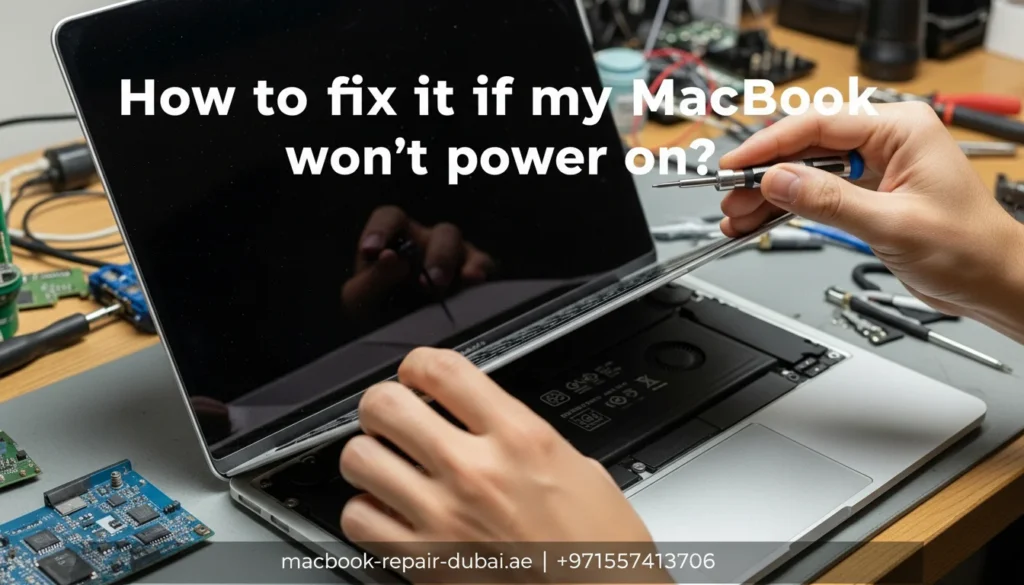
How to fix it if my MacBook won’t power on? It can be not very pleasant when your MacBook does not turn on. You press the power button, but nothing happens, no sound, no screen light, no Apple logo. The device is unresponsive. These issues can make you worried, especially if you depend on your MacBook for work or studies. If you are experiencing this issue, Macbook Repair Dubai offers expert advice and professional repair services. There is no need to worry; most cases can be resolved with simple troubleshooting steps. Whether it is a charging issue, a software fault, or a hardware problem, we will guide you through easy steps. Let’s get your MacBook functional again. Why Won’t My MacBook Turn On? Before we delve into the fixes, let’s quickly understand why your MacBook would not turn on. Common reasons include: Battery issues: The battery might be finished or damaged. Charger problems: A faulty charging cable or adapter can stop the MacBook from charging. Software glitches: Sometimes, macOS can lock up or crash, stopping the MacBook from powering on. Hardware failure: A damaged power button, logic board, or other internal parts can also cause this issue. For additional reading, explore our article on MacBook battery replacement costs. How to Fix a MacBook That Won’t Power On Let’s go step by step and try some simple fixes. Step 1: Check the Power Connection Ensure that the charger is securely connected to both your MacBook and the power outlet. Please make sure the power outlet is functioning by testing it with a different device. Searching for any damage on the charging cable or adapter, exposed wires, or curved connectors can prevent charging. Step 2: Check the Battery Status If your MacBook battery is completely spent, it will not turn on right away. Leave the MacBook plugged in for at least 10-15 minutes before trying to power it on. If your device still is not powering on, it is crucial to replace the battery as soon as possible. Need to change your battery? Visit our MacBook battery service Step 3: Force Restart the MacBook Sometimes, a stuck system stops the MacBook from answering. Press and hold the power button for 10 seconds, then release it and press the button again. If the Apple logo appears, your MacBook is back in action. Step 4: Display Assessment The device is powered on, but the screen is blank. Listen for startup sounds or keyboard backlight if they work, the issues might be your screen. Adjust the brightness or connect to an external monitor to identify a display issue. Step 5: Refresh SMC (System Management Controller) Settings The SMC (System Management Controller) manages power functions and can occasionally malfunction. For MacBooks with fixed batteries For MacBook with removable batteries Shut down your MacBook. Press and hold the Shift + Control + Option keys on the left side, along with the power button, for 10 seconds. Hold all the keys down, then press the power button to turn your MacBook on. Remove the battery and charger. Press and hold the power button for 10 seconds. Afterwards, reconnect all the cables and power the device back on. Step 6: Check for Hardware Issues Examine your MacBook for physical damage, like dents or water exposure. If the charger’s light is not coming on, the power adapter may be faulty. If you doubt hardware damage, bring your device to MRD for expert service. Step 7: Boot in Safe Mode Safe mode helps fix software issues that prevent normal startup. Power off your MacBook completely. Press the power button, then quickly hold the Shift key until the Apple logo shows up. If the MacBook starts in safe mode, restart it normally and see if the issue is resolved. Step 8: Run Apple Diagnostics Apple diagnostics check for hardware problems. Disconnect all external devices right away, including USB drives and headphones. Please turn off your MacBook and then turn it on while pressing D. Follow on-screen instructions and note any error code; these will help technicians understand the problem better. When to Seek Professional Help If you have noticed all these steps and your MacBook still does not turn on, it is time to get professional support. At MRD, our skilled technicians can quickly determine and fix hardware and software problems. Whether it is a battery replacement, screen repair, or internal damage, we have got you realize. Conclusion A MacBook that would not power on can feel like a serious issue, but it is often an easy solution. By following these simple troubleshooting steps, you can fix the issue yourself. If the problem continues, do not hesitate to visit MacBook Repair Dubai for fast, reliable repair services. Need quick assistance? Contact Us today and get your MacBook back in perfect shape. Final Contact Form First NameLast NameEmailPhone NumberDevice ModelYour MessageSubmit Form Related Posts Mac Power Solutions Mac Power Problems Mac Power Consumption How to fix it if my MacBook won’t power on? March 7, 2025-Abdul Aziz … Read More… Why is My MacBook Pro Battery Draining So Fast? March 3, 2025-Abdul Aziz … Read More… How much does a MacBook Pro battery cost? August 29, 2024-Abdul Aziz … Read More…
2 Monitors attached to the MacBook Air M2
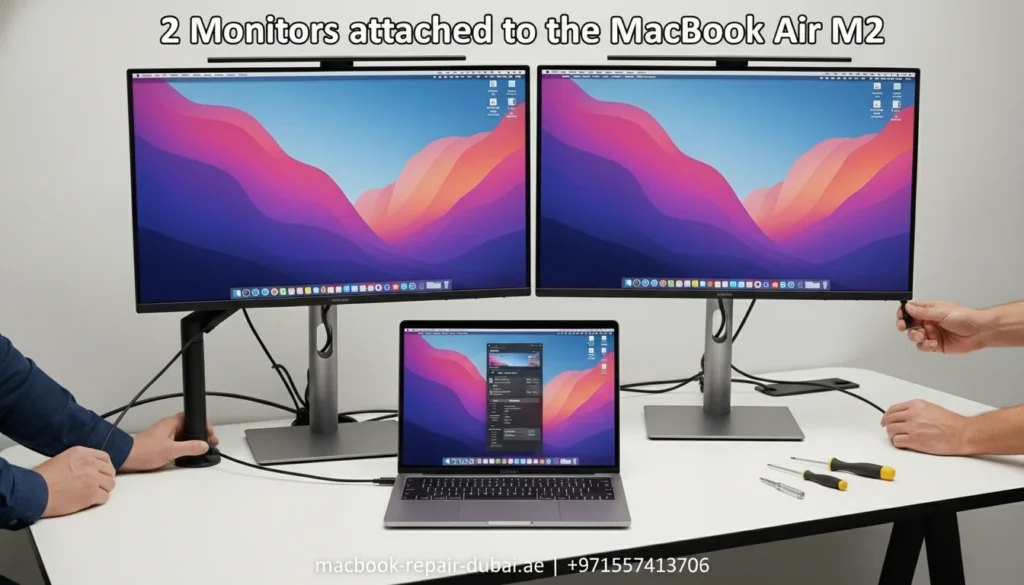
2 Monitors attached to the MacBook Air M2 MacBook Air M2 users often face difficulties when connecting two external monitors. Common issues include one monitor not being examined for resolution differences or limited display options due to the MacBook Air’s single external display support. It can be inconvenient for people who use multi-monitor setups for productivity or creative work. Thankfully, there are methods for effectively connecting two monitors to a MacBook Air M2. With DisplayLink adapters, settings modification, or using appropriate hubs, a dual-monitor configuration is possible. If these steps do not work, Macbook Repair Dubai is here to provide expert support. Step-by-Step Guide to Connect Two Monitors to Your MacBook Air M2 Step 1: Understand the Limitation The MacBook Air M2 naturally supports only one external display via its Thunderbolt/USB-C port. To connect two monitors, you will need third-party solutions like a display link adapter. Step 2: Get the Right Equipment Buy a display link dock or adapter that supports dual monitors. Make sure your monitors have the suitable inputs (HDMI, Display Port, or USB-C). Step 3: Install the DisplayLink Software Go to the official display link website and download the needed drivers for macOS. Install the software and restart your MacBook to ensure compatibility. Step 4: Connect the First Monitor Use one Thunderbolt/USB-C port to connect the first monitor directly or through a center. Confirm that your monitor is powered on and correctly set to the right input source. See our guide on how to fix it if my MacBook won’t power on for more screen troubleshooting tips. Step 5: Set Up the Second Monitor via DisplayLink Connect the display link adapter or dock to your MacBook Air. Attach the second monitor to the adapter using HDMI or display port. Step 6: Configure Display Settings Open System Settings > Displays on your MacBook. Arrange the monitors to match your physical design and set the desired resolution for each. Adjust settings for extended or mirrored displays. Look for dents, water damage, or frayed cables—if you suspect any, see our page on MacBook not powering on due to hardware damage. Step 7: Test Your Setup Ensure both monitors display properly. If any issues occur, check your connections, restart your MacBook, or update the display link driver. Seek Professional Assistance A MacBook that won’t power on can usually be fixed with simple troubleshooting, but if it needs deeper work, don’t hesitate to visit Contact Us. Our team at MacBook Repair Dubai is here to help—fast, reliable service to get your device back in working order! Conclusion While the MacBook Air M2 is limited to one native external display, connecting two monitors is still achievable using DisplayLink adapters and the right setup. By following the step-by-step guide above—choosing the correct equipment, installing necessary drivers, and adjusting display settings—you can enjoy an efficient dual-screen workspace. Still facing display issues or hardware limitations? Let the experts at MacBook Repair Dubai help. Our team offers quick diagnostics and effective solutions to ensure your MacBook Air M2 and external monitors work flawlessly together. Upgrade your productivity today with a seamless dual-monitor experience in Dubai. Final Contact Form First NameLast NameEmailPhone NumberDevice ModelYour MessageSubmit Form Related Posts Mac External Monitor Dual Monitor Setup MacBook Pro M4 with Thunderbolt 5 and portable monitor March 3, 2025-Abdul Aziz … Read More… 2 Monitors attached to the MacBook Air M2 March 3, 2025-Abdul Aziz … Read More…
How can I fix the missing Touch Bar controls for the Calculator in MacBook Pro?
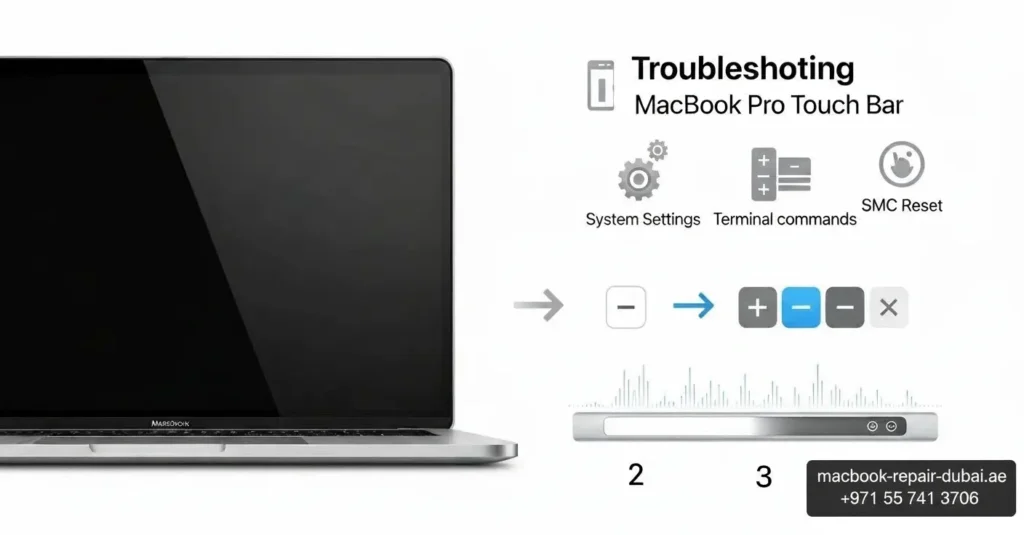
How can I fix the missing Touch Bar controls for the Calculator in MacBook Pro? Users of the Mackbook Pro like the Touch Bar for its ease, but sometimes specific controls like the calculator shortcuts may disappear, leaving you irritated. This issue may occur due to old software, incorrect settings, or a temporary fault. Consequently, accessing commonly used functions such as the calculator from the Touch Bar becomes challenging. Luckily, restoring the missing calculator controls is so simple that it can be solved with a few steps. Adjusting the Touch Bar or resetting and updating macOS helps in resolving these issues.If the issues persists, MacBook Repair Dubai is always ready to assist you with expert support. Step-by-Step Guide to Fix Missing Calculator Controls on Touch Bar Step 1: Check for macOS Updates. Open system settings and go to general > software update. If an update is available, install it to keep your macOS updated and running smoothly. Step 2: Optimize Your Touch Bar Ssttings Navigate to System Settings, then go to Keyboard and select customize control strip. Copy and paste the calculator icon back to the Touch Bar if it is missing. Press done to save changes and check if the controls appear. Step 3: Restart the Touch Bar Open the terminal app from Applications > Utilities. Type the following command and press enter: ”sudo pkill TouchBarServer” It will restart the Touch Bar, possibly fixing any temporary fault. Step 4: Reset NVRAM/PRAM Shut down your MacBook Pro. Turn it on, then immediately press and hold Option + Command + P + R for about 20 seconds. Release the keys, and let your MacBook restart. Step 5: Test in Safe Mode Restart your Mac and keep holding the shift key while it boots to access Safe Mode. Check if the calculator controls appear on the Touch Bar. If they do, a third-party app or login items may be disrupted. Step 6: Reinstall macOS (Optional) If the issue persists, consider reinstalling macOS to resolve deeper system problems and back up your data before proceeding. Get Expert Assistance If none of the above steps resolve the issues, it may be due to a hardware problem. Contact Us MacBook Repair Dubai for professional diagnosis and repair services. Our qualified specialist will get your Touch Bar to work flawlessly once more. Using these steps, you can get the missing calculator controls back and fully utilize the MacBook Pro Touch Bar. Conclusion Losing the calculator controls from the Touch Bar can be frustrating, especially when you’re used to quick access. Thankfully, most issues can be resolved by updating macOS, customizing Touch Bar settings, restarting services, or resetting system memory. These quick steps can bring your productivity tools back in no time. Still missing Touch Bar functions? Get professional help at MacBook Repair Dubai. Our expert technicians can fix hardware or software issues efficiently, ensuring your Touch Bar works flawlessly. Don’t let small glitches slow you down—get fast, reliable MacBook support in Dubai today. Final Contact Form First NameLast NameEmailPhone NumberDevice ModelYour MessageSubmit Form Related Posts Mac Guide Why Is My MacBook (M3) Not Charging? May 22, 2025-Abdul Aziz … Read More… How Can I Fix a MacBook Air That Won’t Charge? May 22, 2025-Abdul Aziz … Read More… How to Take a Screenshot on a MacBook May 15, 2025-Abdul Aziz … Read More… How to Change MacBook Name May 15, 2025-Abdul Aziz … Read More… How to Install Windows on MacBook Pro May 15, 2025-Abdul Aziz … Read More… How to Reset a MacBook May 15, 2025-Abdul Aziz … Read More… Load More End of Content.
How to Clean MacBook Pro Keyboard

How to Clean MacBook Pro Keyboard? If your keyboard is not working correctly and you want proper guidelines for cleaning your MacBook Pro keyboard to prevent damage from dust or liquid spills. Regular cleaning is essential for the longevity and optimal performance of your keyboard. Here, you’ll find complete guides on how to clean your MacBook Pro keyboard and remove persistent smudges or dirt. Why Clean Your MacBook Pro Keyboard Cleaning a keyboard is important to: Make the Keyboard smooth to use and speedy to work quickly. Decrease the risk of illness as your habit of eating and drinking near your device. Remove dust or moisture to prevent keys from getting stuck and unresponsive. Maintain a pleasant appearance and be more professional. Prolong keyboard lifespan. Improve typing experience. Prevent stubborn stains and intensive damage. Maintain/increase the resale value. Avoid overheating. Optimize performance. Materials Required for Cleaning a MacBook Keyboard Soft, lint-free microfiber cloth Compressed air container Distilled water Isopropyl solution (70%) Small, soft-bristled brush Cotton swabs Toothpick (Optional) A vacuum cleaner with an attached soft brush Precautions During Cleaning Process Turn off your MacBook Pro. Unplug your Mac from the power supply. Don’t use an abrasive cloth or towel to clean your Keyboard. Make sure your cleaning cloth has no excessive water so that keys can’t be damaged from moisture. Avoid harsh cleaners such as abrasive cleansers, bleach, and cleaners containing alcohol or other toxic chemicals, as they damage the Keyboard. Use 70% isopropyl solution or distilled water to clean the Keyboard safely. Avoid directly spraying the solutions. Apply them on the cloth, and then wipe the Keyboard. Clean in a dust-free environment. Use proper tools and remove the keys carefully. Be gentle and first test in a small area. How to Clean MacBook Pro Keyboard: Follow the instructions below and clean your MacBook keyboard from liquid spill, grease, dust, or debris. Step 1: Shuts Down Your Device Turn off your MacBook Pro completely to avoid any internal damage from water or solution used in the cleaning process. Step 2: Unplug the Mac Before cleaning, unplug your Mac from the power supply or remove the battery if your device has a removable one. Step 3: Remove Initial Dust or Debris Remove the initial dust or debris with the help of a vacuum and compressed air container before using water or any cleaning solution. Use a vacuum with the attached brush, clean each key carefully, and avoid the key’s damage. Step 4: Detailed Cleaning Clean the Keyboard inside and out with a bristle brush and move the brush in zigzag patterns to remove remaining dust particles. Step 5: Clean with Water Wipe the keys with a soft, clean microfiber cloth, slightly damp, into distilled water. Avoid excessive water, and do not directly apply water onto the Keyboard; it could seep into the Keyboard and damage it internally. Wipe carefully between the keys, ensure each corner is clean perfectly, and protect them from extra moisture. Step 6: Deep Cleaning Using IPA Solution: If you see that stubborn stains exist and need to clean sticky keys, then take 70% of the isopropyl solution onto a cotton swab and wipe the Keyboard again to remove persistent stains or marks. Remove the keycaps and wipe under the keys properly. Remember, do not spray directly onto the Keyboard. Step 7: Dry the Keyboard Finally, dry the Keyboard with another clean microfiber cloth and reattach the keycaps. Avoid dryers or any other heat-producing material to dry. Moisture can damage internal components and lead to short circuits, so leave for a few minutes to dry the Keyboard completely before you turn on your MacBook. Step 8: Final Testing After the cleaning process, turn on the MacBook and observe the proper functionality of the Keyboard. If any malfunction arises, then visit us; our technicians work in a professional setting using the material to clean your devices. Maintenance tips Clean regularly Clean your Mac’s Keyboard regularly with a soft microfiber cloth, and it avoids the accumulation of dust or debris. A quick weekly brush and wipe can go a long way in maintaining a clean keyboard. Keep the MacBook Closed When Not in Use Make sure your MacBook Pro is closed when it is not in use, it helps to maintain a clean keyboard and avoid dust from entering into the keys Avoid Dining while using your MacBook Pro Whenever you use your Mac, prevent Dining or beverages and minimize the risks of spills to damage the Keyboard. Wash your hands before using Every time you wash your hands before using the Keyboard save it from oil and moisture to make sticky keys. Use compressed air regularly Regularly clean your Keyboard using compressed air and blow out the dust or particles that accumulate between the keys and make them sticky and unresponsive. Seek professional guides Whenever you experience a minor disturbance with your keys or the Keyboard is malfunctioning, immediately clean it. Our Professional Cleaning Services For heavy liquid spills or physical damage, contact us at MacBook Repair Dubai for professional cleaning of your MacBook Pro keyboard. We clean the keyboards safely in a dust-free environment and ensure the sticky or unresponsive keys to smooth pressing. Please stay connected with us for more tips and tricks to maintain your Mac’s productivity and increase the lifespan. Conclusion A clean MacBook Pro keyboard not only improves your typing experience but also protects your device from dust, spills, and long-term damage. By following the safe cleaning steps and using proper materials like microfiber cloths and isopropyl alcohol, you can maintain a smooth and responsive keyboard with minimal risk. If your keyboard remains sticky, unresponsive, or has suffered a liquid spill, don’t take chances. Visit MacBook Repair Dubai for expert keyboard cleaning and repair. Our professional service ensures your MacBook stays in top shape—clean, reliable, and ready to perform. Let us help you protect your device and extend its lifespan. Final Contact Form First NameLast NameEmailPhone NumberDevice ModelYour MessageSubmit Form Related Posts MacBook Screen
How to Fix a Broken MacBook Screen?
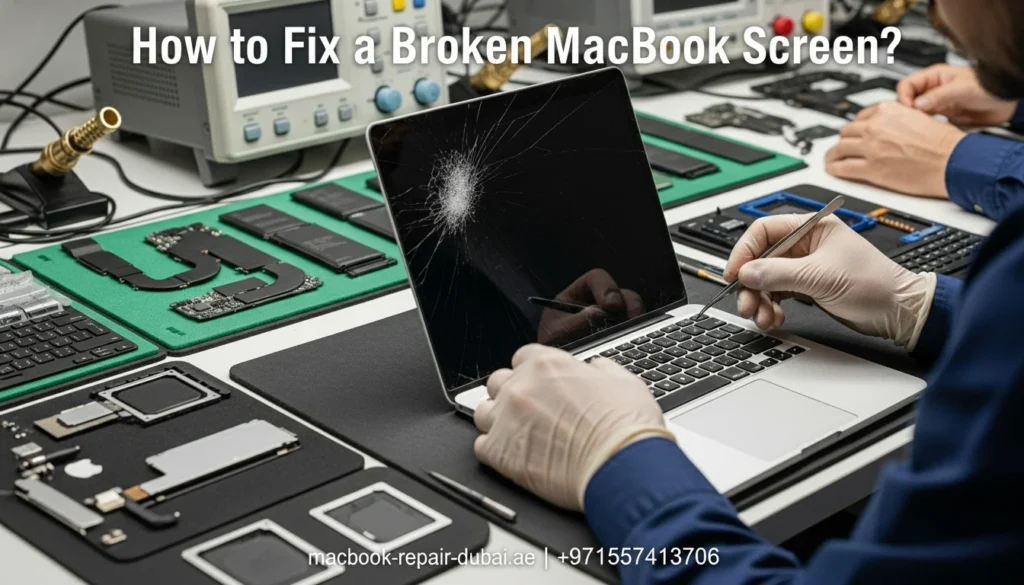
How to Fix a Broken MacBook Screen A broken or cracked screen can cause various display issues, including a blank screen, flickering, dead pixels, and the screen not turning on. Repairing a cracked or shattered screen is a complex process that requires technical knowledge and expertise. After reading this, you’ll be able to diagnose whether your MacBook’s screen has physical damage, display issues, or functional problems. We at MacBook repair Dubai provide an effective solution in our guide, ‘How to Fix a Broken MacBook Screen.’ So, relax and keep reading! Can You Fix a Broken MacBook Screen at Home? A broken MacBook screen is repairable at home and can be functional again if there are minor cracks on the screen with a few display issues. Or even if there is physical damage to the panel with extra display issues, it needs to be replaced. It is mandatory to have the latest repair tools and advanced knowledge of techniques to fix a broken screen of a MacBook Air, MacBook Pro, or other Apple devices. Otherwise, it can be risky to repair a broken screen at home. Note: In that case, you are advised to take a professional diagnosis and fix it to secure your MacBook screen from severe physical damage. Before moving to the fixing method, you need to know the types of damage with its severity level your Mac has; Identify Your Screen Damage It is important to determine the level of damage so that better repair solutions can be found. First, identify the types of screen damage and how much it affected so that you have to be clear about whether it is repaired or replaced with a new one. A malfunctioning screen can be repaired easily but when your screen has broken or cracked, it can cause damage in multiple ways: Physical Damage Physical damage can be of two different types. If your screen has minor cracks and is not deep to the LCD, it is repairable. But if you have a deep broken LCD, it must be replaced. Display Issues If you encounter dead pixels, a stuck screen, a blank screen, backlight problems, color distortions, and flickering, it might be possible that your screen has been shattered or broken, but it can be repaired and need a professional fix. Functional Problems It is obvious that when your Mac has a broken screen, its functionality automatically becomes problematic as the touch screen is unresponsive or malfunctioning. It is repairable and can be functional again. Initial Steps to Diagnose a Broken Screen Check erratic behaviors of your screen as displayed in front of you, such as pixelated screen, lines on the screen, blue screen of death and screen freezes or stuck. Identify these initial signs of screen damage and confirm the issue through a simple Apple Diagnostic testing. Run Apple Diagnostic Tools to identify whether the issues are arising actually due to the broken screen or caused by any software failures. Steps for Apple Diagnostic Test Apple provided hardware testing tools in their MacBook products by default. Here are the simple steps to identify the actual problem. Shut down your MacBook and ensure a smooth and fast internet connection. Disconnect the other attached devices from your Mac. If you are using an Intel-based Mac, then turn on it and press and hold the D key immediately. If you have an Apple silicon MacBook, then turn it on, continue and hold the power button until the startup window options appear. After this, leave the power button and press the Command + D keys simultaneously. After that, follow the on-screen instructions, and the test will be completed automatically. Check the final result and identify your Mac’s screen issue. Prepare Your Device For Screen Repair Here are a few points to keep in mind whenever your MacBook faces an accidental dropping of a heavy object or impact and its screen breaks. Don’t panic! Immediately prepare your device for perfect repair and secure from intensive damage. Shut down your device immediately after something bad happens; it would be helpful to save it from further damage, and it is easy to repair. Unplug the power adapter and disconnect external devices to avoid short circuits or other hardware failures. Immediately try to back up your data and secure it from permanent loss. Avoid using your MacBook as causing more severe issues. Please take a picture to identify the damage; it is beneficial for the effective repair of a broken MacBook screen. Look for authentic MacBook screen repair professionals and get your device working soon. How to Fix a Broken MacBook Screen? First of all, it is very important to know that screen repair and broken screen replacement are very sensitive processes. If you do not have enough knowledge and do not know how to use the tools, then you should get the repair from a professional technician instead of repairing yourself. But if you have full confidence, then apply these steps to get your clear and smooth display. Step 1: Prepare by gathering the tools such as; tool kit containing different types of screwdrivers, suction cups, Tweezers, Anti-static Mat and Wrist Strapand, Plastic Cards or Picks, Adhesive Strips, Microfiber Cloth, Distilled water or Isopropyl Alcohol, and Compressed Air Can. Step 2: Turn off your Mac. Step 3: Remove the back cover using screwdrivers. Step 4: Carefully remove the battery. Step 5: Disconnect the broken Screen using screwdrivers, picks and suction cups. Step 6: Clean the new Screen and other Mac components using microfiber cloth and distilled water. Step 7: Install the new Screen and carefully attach the screws. Step 8: Reconnect the battery back. Step 9: Attach the back cover. Step 10: Turn on the MacBook. Step 11: Test the new Screen. Preventive Measures Use Screen Protectors:The Screen is the most sensitive area of your MacBook, so take care of it using different screen protectors and secure it from physical damage like scratches or cracks. Gentle Handling:Handle your Mac gently, keep
